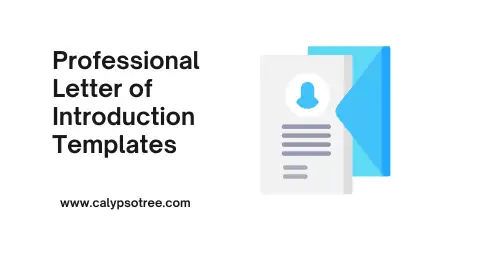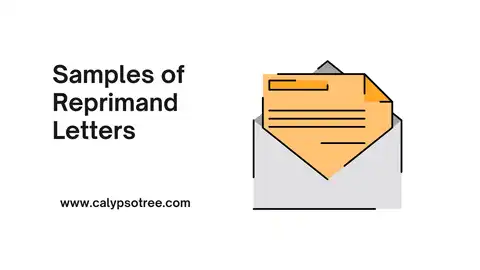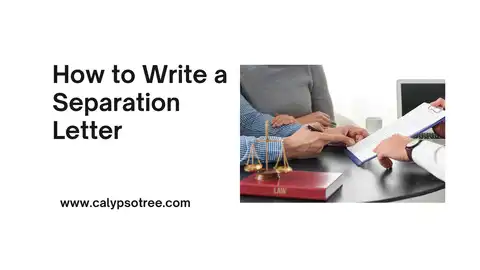Master the art of persuasion with our example persuasive letters. Learn how to write for complaints, proposals, advocacy, and more. Get tips and templates!
Have you ever wanted to convince someone to see things your way? Example persuasive letters are a great way to learn the techniques that get results. Whether you want a change at school, to support a cause, or advocate for yourself, a well-crafted letter can persuade others to take action. Let’s explore what makes a persuasive letter effective and see real-world examples.
What’s a Persuasive Letter?
A persuasive letter is used to convince the reader to take a specific action, think differently about an issue, or change their behavior. It combines logical arguments with evidence and can sometimes use appeals to emotion to make its case.
What are the key elements of a persuasive letter?
Key elements that make a persuasive letter truly effective:
Attention-Grabbing Opening:
This is your chance to make the reader sit up and pay attention. It could be a shocking statistic, a thought-provoking question, a relevant anecdote, or a vivid quote.
Example: “Did you know that 80% of students at our school never have the chance to take a music class?”
Clear Thesis Statement:
Sum up your main point or request in a single, strong sentence. This sets the direction for the entire letter.
Example: “I strongly believe that expanding music education opportunities at our school is vital for student success and well-being.”
Well-Developed Arguments:
This is where you convince the reader with logic and evidence. Each argument should have:
- Topic Sentence: States your reason clearly.
- Supporting Evidence: Use facts, statistics, expert opinions, or real-life examples to back up your claims.
- Explanation: Connect the dots! Show why your evidence supports your main point.
Example: “Studies show that students who participate in music programs have higher test scores.” “Our neighbor school offers five different music classes, and their students consistently outperform ours in academic subjects.” “Music education fosters creativity and problem-solving skills that are essential for success in today’s world.” *
Emotive Language:
Don’t be afraid to appeal to the reader’s emotions. Carefully chosen words and phrases can create a sense of urgency, hope, empathy, or excitement.
Example: Use words like “imagine,” “unfair,” “opportunity,” “vital”
Addressing Counterarguments:
Show that you’ve considered other viewpoints. Briefly acknowledge a potential objection and explain why your position is still stronger.
Example: “While some may argue that expanding music programs would be costly, the long-term benefits to students and our school’s reputation greatly outweigh the initial investment.”
Strong Call to Action:
Don’t just fade out! Explicitly tell the reader what you want them to do – sign a petition, attend a meeting, change a policy, etc.
*Example: “I urge you to consider my proposal and schedule a meeting with me to further discuss how we can bring the transformative power of music to all our students.”
Types of Persuasive Letters
Let’s dive into each type of persuasive letter with more detail:
1. Proposal Letters
Purpose: To outline a solution, suggest a new project, or offer improvements. You’ll target decision-makers (school boards, companies, bosses).
Key Elements:
- Define the problem clearly.
- Detail your proposed solution (be specific about steps and costs).
- Highlight the benefits of implementing your plan.
- Project confidence that you can make this a success.
Example: Writing to your city council proposing a community recycling program.
2. Complaint Letters
Purpose: To express dissatisfaction with a product, service, or situation, and demand action (refund, apology, policy change).
Key Elements:
- State the complaint factually (dates, what happened).
- Explain the impact on you or others.
- Be firm, but polite – avoid rude language.
- Clearly state your desired resolution.
Example: Writing to an online store about a defective product you received.
3. Fundraising Letters
Purpose: To persuade people to donate money to a non-profit organization or cause.
Key Elements:
- Compelling story: Connect the reader emotionally to the issue.
- Explain the problem your organization is trying to solve.
- Show how donations make a tangible difference.
- Make the “ask” easy – include donation methods.
Example: A charity working with homeless animals asking for donations to build a new shelter.
4. Letters of Recommendation
Purpose: To strongly advocate for a friend, classmate, or colleague, highlighting their qualifications for a job, school admission, or award.
Key Elements:
- Describe your relationship to the person and how long you’ve known them.
- Focus on specific skills/achievements that relate to the opportunity.
- Give real examples (don’t just say they’re “smart”, show how!)
- Express enthusiasm and confidence in the person’s abilities.
Example: A teacher writing a recommendation letter for a student applying to college.
Essential writing tips for persuasive letters
Let’s go into more detail on these essential writing tips for persuasive letters:
Keep it Short
Why it Matters: Decision-makers have limited time and attention spans. Long, rambling letters are more likely to be ignored.
How to Do It:
- Focus on your strongest 2-3 arguments.
- Cut unnecessary words and phrases.
- Aim for a single page whenever possible.
Exceptions: If your proposal is complex or you’re outlining technical details, clarity may sometimes be more important than extreme brevity.
Formal Style
Why it Matters: Shows respect, makes you appear serious and professional, and sets you apart from casual emails.
How to Do It:
- Standard Letter Format: Include date, your address, recipient’s address, salutation (“Dear…”), and a closing (“Sincerely…”). Google “business letter format” for exact examples.
- Polite Language: Avoid slang and overly casual phrases. Even if you disagree strongly, be respectful.
- Grammar Counts: Use correct spelling, grammar, and punctuation. This demonstrates care and attention to detail.
Proofread!
Why it Matters: Errors undermine your credibility, especially for persuasive writing where you need to appear intelligent and well-informed.
How to Do It:
- Don’t Rely on Spellcheck: It won’t catch everything (ex: wrong word used but correctly spelled).
- Read Aloud: This helps you catch awkward wording and flow issues.
- Fresh Eyes Help: Ask a friend or family member to proofread it for you. They’re more likely to spot mistakes you might miss.
Extra Tip: Practice writing drafts! The more you write, the better you’ll become at naturally writing a concise, formal, and persuasive style.
When Should I Write a Persuasive Letter?
Life isn’t always perfect. Sometimes you need to take a stand to fix something that’s wrong, support a cause, or convince someone to think your way. That’s where persuasive letters come in!
Fixing Problems
- Bad Experience? If a store treated you unfairly or you bought something broken, a complaint letter can get you a refund or a chance for them to make things right.
- Got an Idea? See something that could be better at school, in your town, or even your job? Write a persuasive proposal letter to suggest your solution to the people in charge.
Making Your Voice Heard
- Speak to Leaders! Whether it’s about needing a new park or a big world problem, persuade your elected officials in government to listen and take action.
- News Got You Fired Up? Write an opinion letter to the newspaper to share your strong feelings and get others talking about important issues.
Helping Others (and Yourself!)
- Support a Cause: Explain why a charity or group is awesome and use persuasive writing to get people to donate money so they can do even more good.
- Boost a Friend: Write a letter of recommendation to help a friend get a job or get into school. Highlight their amazing skills!
- Job Hunt Helper: Sometimes, a great cover letter can persuade a company that you’re the perfect fit for the job, even more than a plain resume.
Companies Need to Hear From You!
- Love or Hate It? Let companies know directly how you feel about their products. This can make them change things for the better.
Key Point: Persuasive letters are about more than complaining. Use them to make real changes and help others!
Persuasive Letter vs. Argumentative Essay: What’s the Difference?
Both persuasive letters and argumentative essays are designed to convince someone, but they do it in slightly different ways. Think of it like this:
- Persuasive Letter: It’s like a super-focused sales pitch. You have one main goal (getting someone to do or believe something) and you go all in to achieve it.
- Argumentative Essay: It’s like a debate in written form. You present your side, address the other side, and use lots of evidence to prove your point is the strongest.
Here’s a quick breakdown:
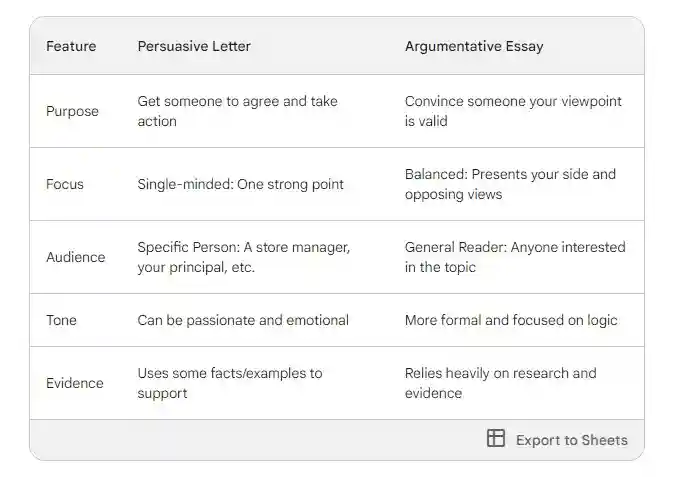
- Feature: This column lists the different aspects we’re comparing.
- Persuasive Letter: This column describes how persuasive letters handle each feature.
- Argumentative Essay: This column explains how argumentative essays differ.
Purpose:
- Persuasive Letter: Get someone to agree and take action.
- Argumentative Essay: Convince someone your viewpoint is valid.
Focus:
- Persuasive Letter: Single-minded: One strong point.
- Argumentative Essay: Balanced: Presents your side and opposing views.
Audience:
- Persuasive Letter: Specific Person: A store manager, your principal, etc.
- Argumentative Essay: General Reader: Anyone interested in the topic.
Tone:
- Persuasive Letter: Can be passionate and emotional.
- Argumentative Essay: More formal and focused on logic.
Evidence
- Persuasive Letter: Uses some facts/examples to support your point.
- Argumentative Essay: Relies heavily on research and evidence.
Example Time! Imagine you want your school to ban junk food sales. Here’s how it might look:
- Persuasive Letter: Write to the principal, focusing on the harms of junk food and the benefits of healthy options. Use emotional appeals about students’ health.
- Argumentative Essay: Discuss BOTH sides of the issue, including arguments for freedom of choice. Show with evidence why the benefits of a ban outweigh any downsides.
How do you structure a persuasive letter?
Here’s a breakdown of how to structure a persuasive letter,:
Structure of a Persuasive Letter
Introduction
Attention-Grabbing Opening: Start with a compelling element to capture your reader’s interest. This could be:
- A thought-provoking question
- A surprising statistic or fact
- A short, relevant anecdote or story
Thesis Statement: Clearly and concisely state the purpose of your letter and your desired outcome.
Body Paragraphs
Develop Your Arguments: Each paragraph should focus on a single, strong reason supporting your position. Follow this structure:
- Topic Sentence: Introduce your reason.
- Supporting Evidence: Use facts, statistics, expert opinions, examples, or logical reasoning to back up your claim.
- Explanation: Connect your evidence to your thesis, demonstrating why it supports your main point.
Address Counterarguments: Show that you’ve considered opposing viewpoints. Briefly acknowledge a potential objection and explain why your position is still stronger. This adds credibility.
Emotive Language (Use Sparingly): While your primary focus is logic, carefully chosen words and phrases can appeal to the reader’s emotions and make your argument more persuasive.
Conclusion
- Summarize Key Points: Reiterate your strongest arguments in a way that leaves a lasting impression.
- Call to Action: Explicitly tell the reader what you want them to do – sign a petition, support a policy, make a donation, etc.
- Closing: End the letter with a polite closing (“Sincerely,” “Respectfully,” etc.) followed by your signature.
What kind of language should use in a persuasive letter?
The best persuasive letters find a balance between these approaches:
Logical & Authoritative:
- Facts, statistics, and expert opinions to back up your claims
- Clear, precise language that states things confidently
- Example: “Studies show that students who participate in music programs score 15% higher on standardized tests.”
Emotional & Persuasive:
- Words that evoke feelings in the reader (hope, frustration, excitement)
- Vivid descriptions that create a picture in their mind
- Short, powerful statements
- Example: “Imagine a school where every student has the chance to unlock their creative potential.”
Respectful & Understanding:
- Acknowledge potential objections, showing you’ve thought about all sides
- Polite phrasing, even when expressing strong opinions
- Example: “While funding may be a concern, investing in the arts has long-term benefits that outweigh the initial costs.”
Should I include evidence to support my claims in a persuasive letter?
YES! Evidence is the backbone of a persuasive letter. Here’s why:
- Credibility: It shows you’ve done your research and aren’t just stating baseless opinions.
- Authority: Facts and expert opinions make you seem more knowledgeable and trustworthy.
- Impact: Numbers and real-world examples make problems more tangible for the reader.
What are common mistakes to avoid when writing a persuasive letter?
Here’s common mistakes and how to avoid them:
Mistake 1: Weak Arguments
- Problem: Relying on opinions without backing them up. (“It’s just not fair!”)
- Solution: Use facts, statistics, examples, and expert opinions to make your arguments rock-solid.
Mistake 2: Too Emotional
- Problem: Ranting or getting overly emotional makes you seem less serious.
- Solution: Passion is great, but balance it with logic and reason. A few well-placed emotional words can be powerful, but don’t overdo it.
Mistake 3: Attacking the Other Side
- Problem: Insulting those who disagree makes you look stubborn, not persuasive.
- Solution: Briefly acknowledge the other viewpoint respectfully, then show its flaws and explain why your position is stronger.
Mistake 4: Forgetting the “Ask”
- Problem: You wow them with arguments, but then…nothing.
- Solution: Have a super-clear call to action. Tell the reader exactly what to do (sign, donate, change a rule, etc.)
Mistake 5: Sloppy Presentation
- Problem: Typos, bad grammar, or weird formatting make you seem less credible.
- Solution: Proofread carefully! Get a friend to help. Look up the proper business letter format if you’re sending a formal letter.
Extra Mistakes to Watch Out For:
- Being Too Vague: Get specific about what the problem is and the solution you propose.
- Sounding Robotic: Write like you’re talking to a real person – avoid overly formal or generic language.
- Going on Too Long: Get to the point! Busy people won’t read a super long essay.
Tips for Writing Powerful Persuasive Letters (With Examples)
Here’s strategies to make your persuasive letter pack a convincing punch:
Know Your Audience
- Who are you addressing? Tailor your arguments and word choice to fit the reader. A letter to your principal will be different from one to a local politician.
- What do they care about? Consider their priorities and values. Frame your arguments in a way that aligns with what motivates them.
Passion with Logic
- Show you care: Enthusiasm is infectious! Let the reader feel why this issue matters to you.
- But don’t forget the facts: Solid evidence builds trust and backs up your passion, making your argument impossible to dismiss.
- Example: Instead of just saying “Art classes are important!”, explain the proven benefits or link it to skills employers look for.
The Power of Storytelling
- Start with a hook: A short anecdote about someone affected by the issue makes it relatable.
- Use vivid examples: Rather than vague problems, show the real impact on people’s lives.
- Paint a better future: Describe the positive change your solution could bring.
Smart Word Choices
- Strong verbs: Avoid weak phrasing like “I think”, use action words (“support”, “invest”, “change”).
- “Power” words: Use a few carefully placed words that evoke emotion (“unjust”, “vital”, “transform”). But don’t overdo it!
- The Rule of Three: Repeating a phrase or idea three times makes it stick in the mind (“Our school needs change, needs opportunity, needs art education.”)
Anticipate & Address Objections
- Think like your opponent: What would someone who disagrees with you say?
- Acknowledge their point, then counter it: This shows fairness and makes your argument stronger.
- Example: “Some may say arts funding is expensive, but studies show it leads to improved overall academic performance, making it a wise investment”
Bonus Tip: Read Your Letter Aloud! This helps you catch awkward phrasing or spots where the tone sounds weak or over-the-top.
Example Persuasive Letters
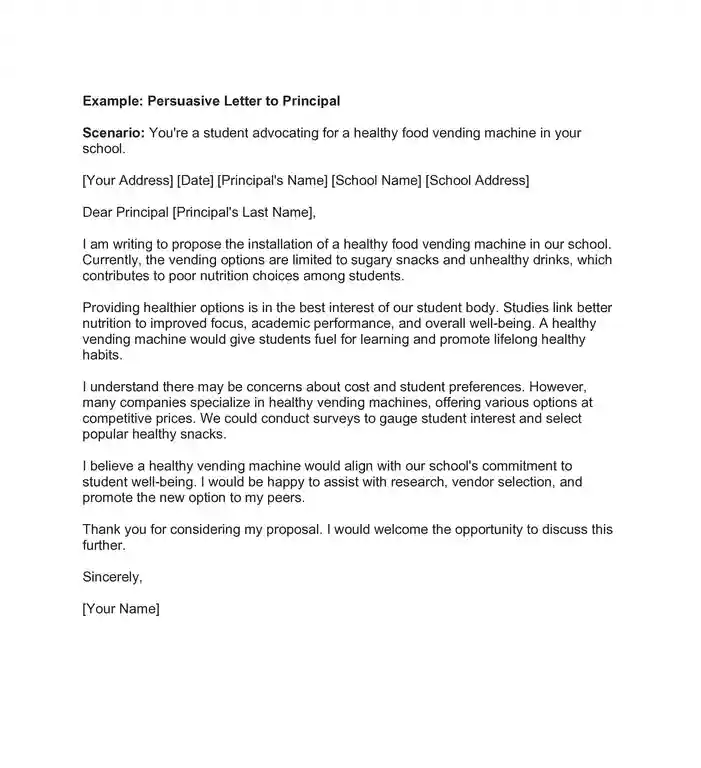
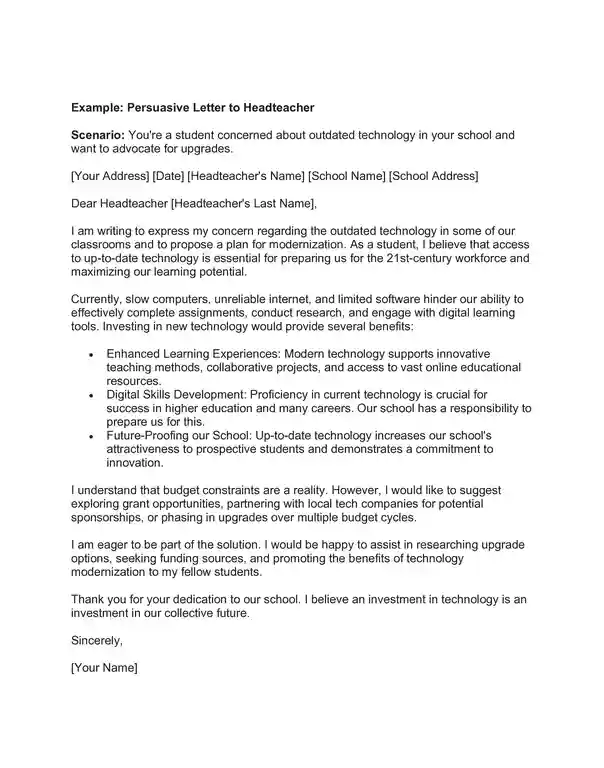
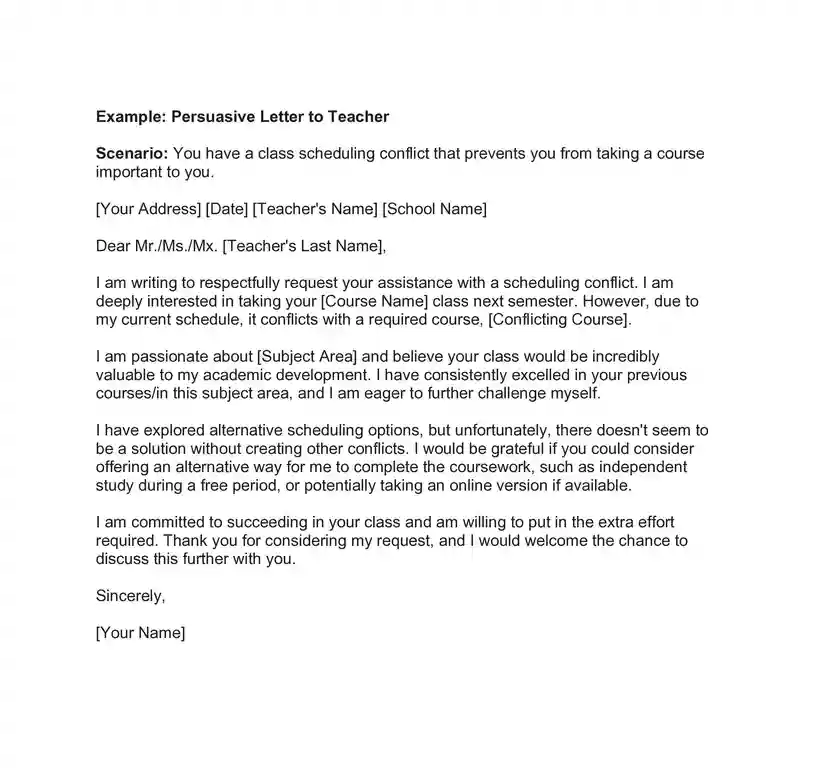
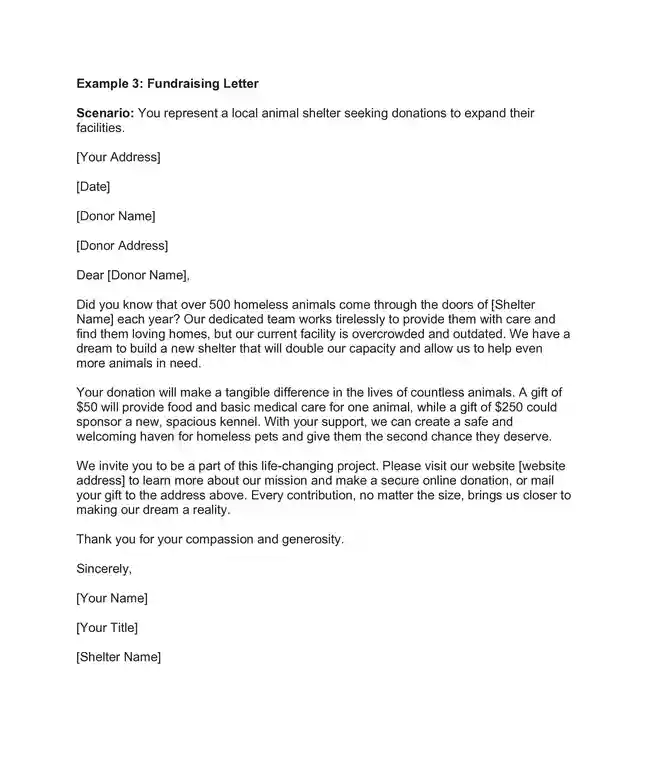
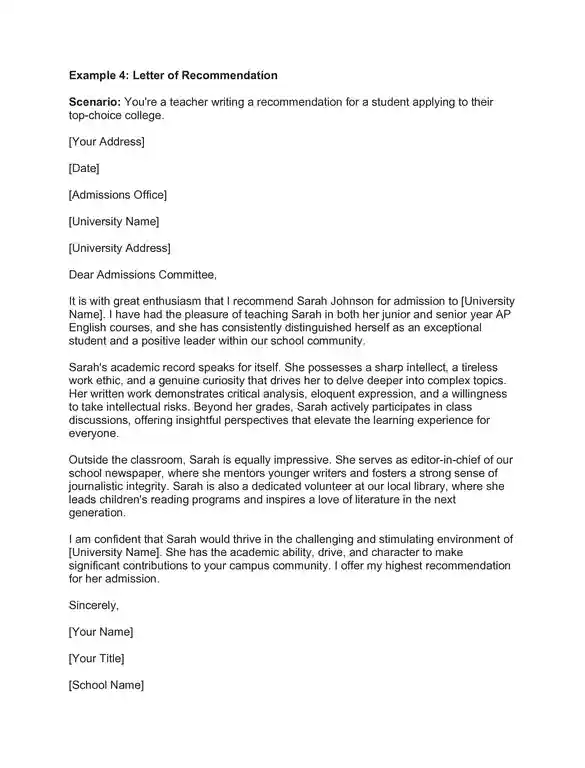
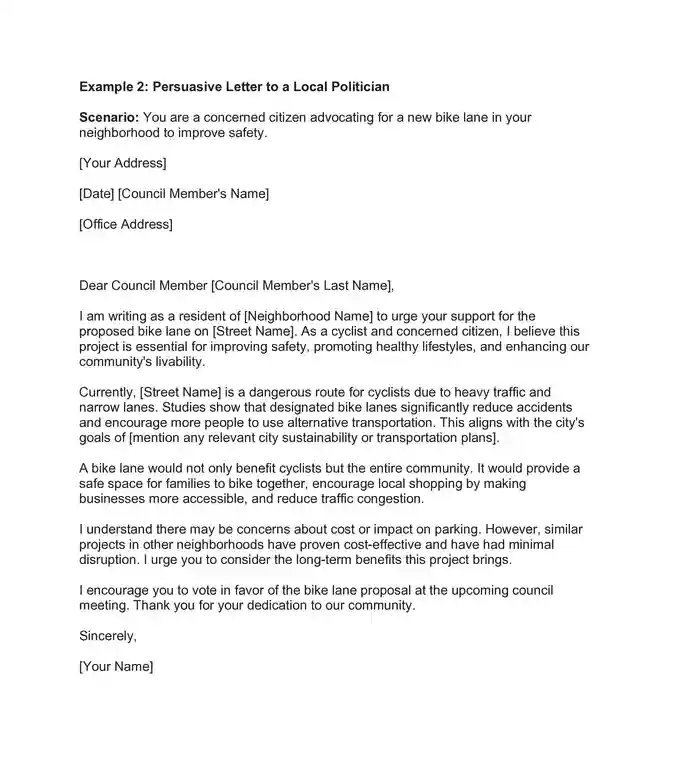
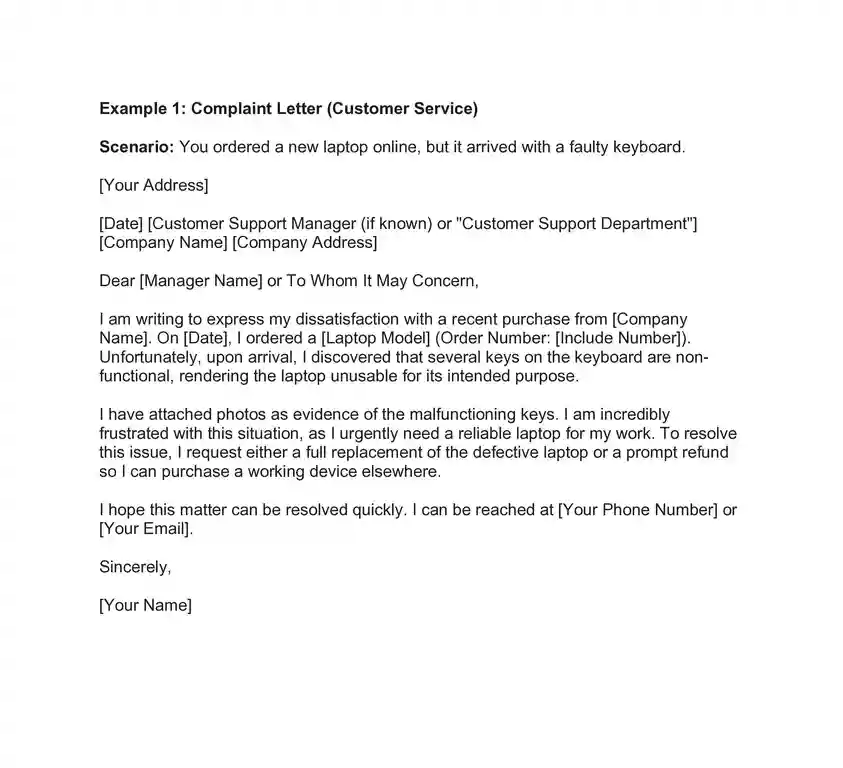
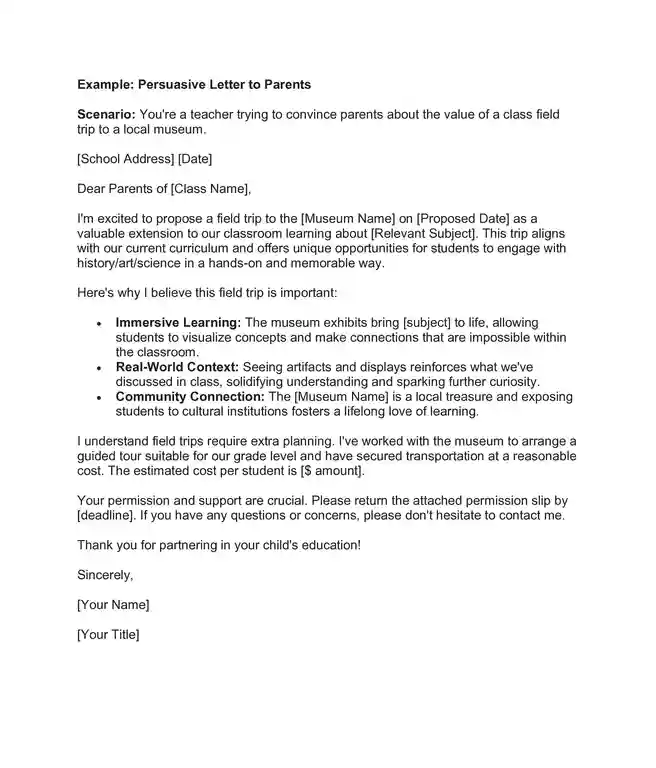
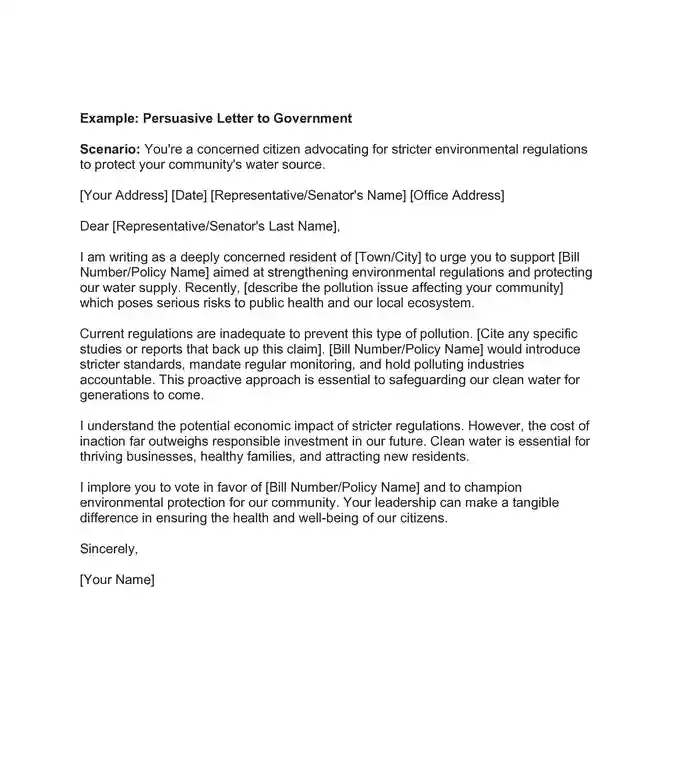
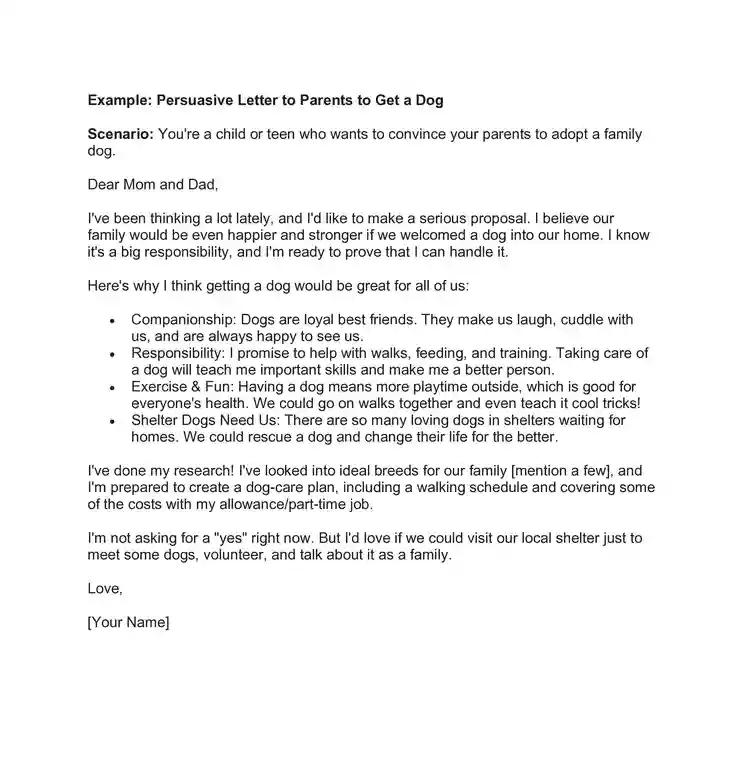
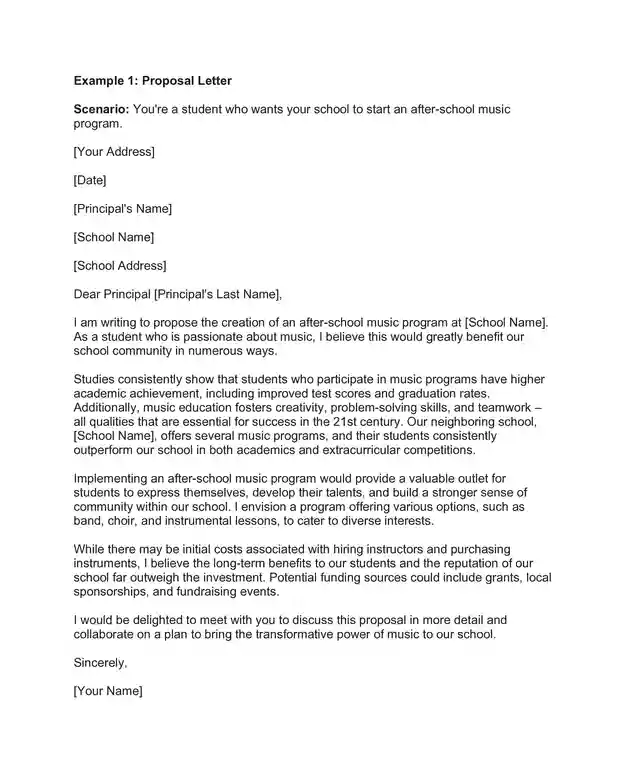
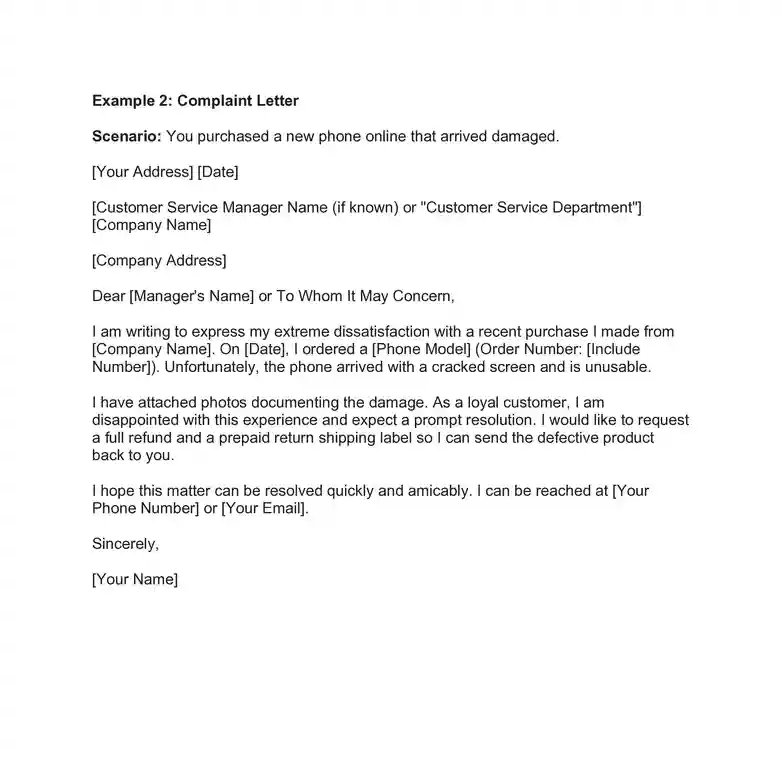
Conclusion
“Example persuasive letters show the power of words to create change. Use them to advocate for positive initiatives, support causes you believe in, and help others. With a clear goal, strong arguments, and a touch of passion, your letters can make a real difference in the world.”
“Ready to write your own persuasive letter? Download our free template here!” (if you have a template to offer).
FAQS: Persuasive Letters
What’s the difference between a persuasive letter and an opinion essay?
Both aim to convince the reader, but a persuasive letter is more focused and targeted towards a specific person to achieve a specific action. An opinion essay is broader, intended to persuade a general audience about a viewpoint.
Can I use stories or emotional appeals in a persuasive letter?
While your primary focus is logic, a compelling story or a few well-chosen words that connect with the reader’s emotions can make your letter more impactful.
How long should a persuasive letter be?
Strive for brevity! Ideally, keep it around a page. Busy decision-makers are more likely to read a shorter, clearly-focused letter.
Do I need to cite the sources of my evidence?
If you’re using specific research or statistics, briefly mentioning the source adds credibility (“According to a recent study by…”). For more general facts, citations aren’t usually necessary.
Can I get help writing my persuasive letter?
Absolutely! Teachers, parents, or tutors can help you brainstorm arguments, edit drafts, and ensure your letter has a professional tone. You can also find online templates and examples for inspiration.
Should I write a persuasive letter by hand or type it?
Typed letters are generally more professional, especially if addressing businesses or officials. Handwritten letters can be effective for very personal pleas or when targeting older audiences who might appreciate the traditional touch.
How do I find the right person to address my persuasive letter to?
Do some research! If you’re addressing a company, look for the customer service or CEO contact. For schools, find the principal or school board contact information. Websites usually have this information.
What if I don’t get a response to my persuasive letter?
Don’t be discouraged! It might be worth a polite follow-up email or phone call a week or two later, reiterating your request. If still no response, consider amplifying your voice by rallying others who support your cause
Can persuasive letters be sent as emails?
Yes, though the formatting may change slightly. Keep the email concise, have a strong subject line, and still include a formal salutation and closing.
Is there a specific persuasive letter format I have to follow?
Standard business letter format is recommended. This includes your address, date, recipient’s address, salutation, the body of your letter, and a closing. You can easily find templates online.

The content creator team at calipsotree.com is dedicated to making topics accessible to everyone, with over 9 years of experience in writing and breaking down complex concepts into easy-to-understand articles that answer readers’ financial questions.






